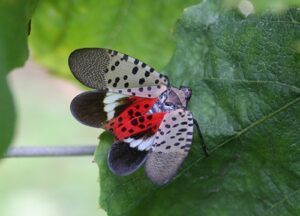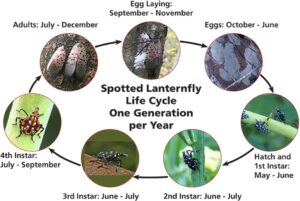By Renee Frith

Do you ever feel like you’re being followed? That was my recent feeling after reading an article in the Courier Journal entitled The Dangerous Spotted Lanternfly is Nearing Kentucky. I moved to Kentucky from Wilmington, Delaware a little over a year ago. In late 2018, spotted lanternfly (Lycorma delicatula) was establishing a foothold in Northern Delaware, with the preferred host plant being tree of heaven (Ailanthus altissima). The plant community was already battling the invasive nature of this species. Tree of heaven is a fast-growing tree species that outpaces North American native tree counterparts in viable seed produced and shear growth rate. Tree of heaven litters the roadsides along the I-95 northeast corridor and is sometimes mistaken for the native sumac.
An initial thought to spotted lanternfly may have been, “great, now we have something that will eradicate tree of heaven”. One can wish! In actuality, spotted lanternfly has found alternative native hosts such as maple, willow, walnut, grape, hops, apple, and peach (there are currently 70 known host species). Spotted lanternfly are sap feeders and prefer to feast on young tender stems. Sapling trees stand no chance against their voracious appetite. This invasion is concerning because saplings are the next generation on our natural lands. The destruction also has an economic impact, severely damaging the Delaware Valley wine crops.
Spotted lanternfly looks very much like a moth, however they are in the order Hemiptera, which are true bugs. They are more closely related to our recent brood of cicadas than to any moth (order Lepidoptera). Current populations are producing offspring once annually, with a single female laying anywhere from 60-120 eggs. October-April is the ideal time to scout for egg masses on smooth trunks of trees, sides of buildings, or anywhere there is a relatively flat vertical surface. You can disrupt their lifecycle by smearing the egg masses.
The spotted lanternfly goes through 4 instar phases before adulthood. Instar phases 1-3 nymphs are identified by a black body with white spots. Instar phase 4 nymphs come with the addition of orange on their back with white spots and black legs and head. While in the instar phases, spotted lanternfly are tricky to capture. Their jumping capability is less of an arching motion and more forward propulsion. Very fast, and quite frustrating until you learn the pattern. Some of my friends in Delaware have given up trying to manually kill the instars and have resorted to a solution of water, Pine-Sol, and a few sugar packets, which attracts instars and kills them by the hundreds. While I don’t encourage home remedies, I do understand the frustration with the lack of solutions.

Adult spotted lanternflies are gorgeous. They are around one inch in length and have a set of silky grey outer wings, with orange inner wings (both having black spots). The first time I saw one I was mesmerized by its beauty, thinking, “this means trouble”. Adult spotted lanternflies are poor fliers, which makes them easy to smash. They are attracted to metal objects, so each time I would leave the state of Delaware, I checked my car for hitch hikers. The last August I was in Delaware, I took my car to the car wash. While sitting outside under a metal awning, with metal poles, on a metal bench, there were easily over 200 adult spotted lanternflies in an area no bigger than 100 square feet. A child and his mother were also waiting in the same area and were commenting on their beauty at the exact moment I smashed one with my shoe. I saw a moment of sheer horror on the woman’s face, as if she was thinking I was some serial killer. I began to explain that these insects are an introduced species that have gotten out of control and are migrating to other locations in the country via train, plane, and automobile and that along their journey they wreak havoc on native trees and agriculture crops. It is out of obligation to the environment that I smash them, not joy … even though there is a level of satisfaction. She thanked me for the explanation and even let her son start having a smashing good time.
Currently entomologists don’t have all the answers for the total devastation this species will cause, or a definitive strategy for eradication. What we can do at this point as Kentuckians is educate ourselves on identification, and at minimum, report sightings by calling 859-257-5838, or take specimens or send an email to the local Cooperative Extension Office. Living with spotted lanternfly in Delaware became an annual routine of scout for egg masses (report), smear egg masses, come up with creative solutions to catch the nymphs, and smash adults. It’s only a matter of time until spotted lanternfly will be in our state, so let’s be prepared.

